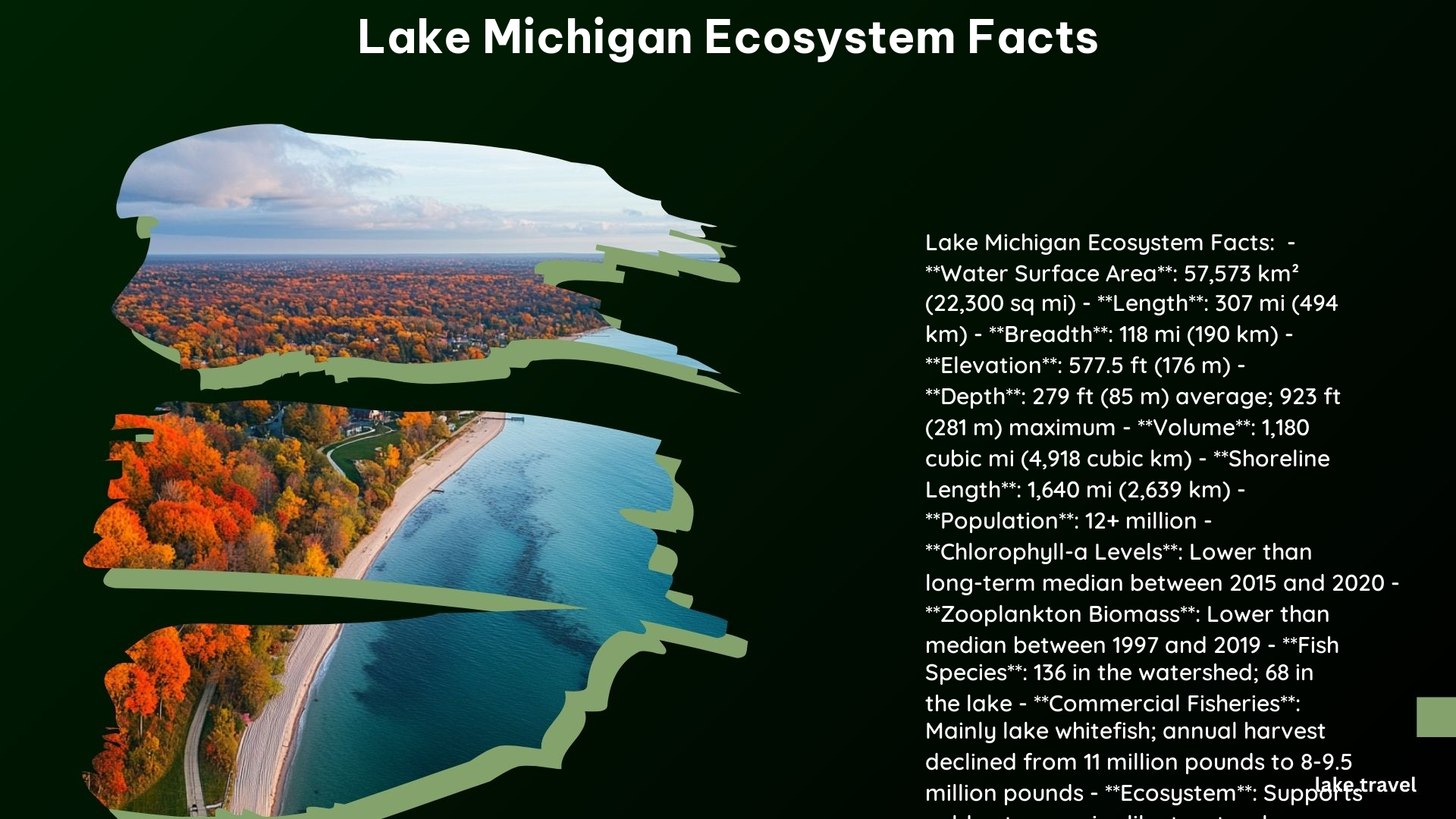Lake Michigan is a vital component of the Great Lakes system, with a rich ecosystem that supports a diverse range of aquatic life and human activities. As a lakes touring enthusiast, understanding the key facts about the Lake Michigan ecosystem can enhance your appreciation and enjoyment of this natural wonder. In this comprehensive guide, we’ll explore the essential details, unique specifications, and fascinating insights about the Lake Michigan ecosystem.
Lake Michigan Basin Statistics

Lake Michigan is the second-largest of the Great Lakes, with the following key statistics:
- Length: 307 miles (494 km)
- Breadth: 118 miles (190 km)
- Elevation: 577.5 feet (176 m)
- Depth: 279 feet (85 m) average; 923 feet (281 m) maximum
- Volume: 1,180 cubic miles (4,918 cubic km)
- Water surface area: 22,300 square miles (57,753 square km)
- Drainage basin area: 45,600 square miles (118,095 square km)
- Shoreline length: 1,640 miles (2,639 km), including islands
- Outlet: Straits of Mackinac to Lake Huron
- Retention or replacement time: 62 years
- Population: 12+ million
Ecology of Lake Michigan

The Lake Michigan ecosystem is characterized by diverse habitats and a delicate balance of aquatic life. Here are some key facts about the ecology of this remarkable lake:
Main Basin
The main basin of Lake Michigan is characterized by cold, clear, and nutrient-poor water, providing an ideal habitat for trout, salmon, whitefish, and other coldwater species.
Open-water Prey Fish
The populations of alewife and bloater, two important open-water prey fish, have declined dramatically since the 1980s, leading to significant changes in the lake’s food web.
Inland Connections
The large rivers and inland lakes that flow into Lake Michigan serve as important habitat connections and nutrient inputs, contributing to the overall health of the ecosystem.
Nutrient Imbalance
Excess nutrients, particularly in areas like Green Bay, can create blooms of algae that die off and decompose, leading to the formation of oxygen-deprived “dead zones” that threaten aquatic life.
Shallow, Rocky Areas
In shallow, rocky areas, excess nutrients can fuel the growth of bottom-dwelling algae that washes ashore and fouls beaches, creating a nuisance for recreational users.
Fisheries of Lake Michigan
Lake Michigan supports a diverse array of fish species, both native and introduced, with a thriving commercial and recreational fishery. Here are some key facts about the fisheries of this Great Lake:
- Fish Species: 136 species in the Lake Michigan watershed, with 68 found in the lake itself.
- Native Species: Lake trout were extirpated by the mid-1950s, but recovery efforts have aided in their partial recovery.
- Introduced Species: Coho salmon, chinook salmon, steelhead, brown trout, and lake trout are now common in the lake.
- Commercial Fisheries: Lake whitefish is the most popular and valuable commercial species, although catches have declined in recent years.
Lake Michigan Communities
The Lake Michigan basin is home to a significant human population, with major urban centers and a thriving tourism industry. Here are some key facts about the communities that rely on and interact with the lake:
- Population: The Lake Michigan basin has the second-highest population after Lake Erie.
- Major Urban Centers: Chicago, IL; Milwaukee, WI; and Green Bay, WI, rely on the lake for shipping, municipal, and industrial water use.
- Tourism: Popular vacation destinations attract tourists to the Lake Michigan shoreline, particularly in Wisconsin and Michigan.
Biodiversity of Lake Michigan
The Lake Michigan ecosystem is home to a diverse array of habitats and species, some of which are globally significant. Here are some key facts about the biodiversity of this remarkable lake:
- Freshwater Sand Dunes: The world’s largest collection of freshwater sand dunes is found along the eastern shorelines of Lake Michigan.
- Ecological Significance: The lake’s ecosystem is globally significant, with a mix of boreal forests, coastal fens, dry sand prairies, and oak savannas.
- Rare Species: Many rare species are found in the Lake Michigan coastal zone, including plants like Pitcher’s thistle and animals like the Piping plover.
Invasive Species in Lake Michigan
The introduction of non-native species has had a significant impact on the Lake Michigan ecosystem. Here are some key facts about the invasive species that have been introduced to the lake:
- Impact: Invasive species like sea lampreys, round goby, zebra mussels, and quagga mussels have caused significant changes in water clarity and fertility, threatening native fish populations.
- Management Efforts: Introduced salmonids, such as brown trout, steelhead, coho, and chinook salmon, were introduced to control invasive species, but their populations have also had significant impacts on the ecosystem.
Monitoring and Conservation Efforts
Ongoing monitoring and conservation efforts are crucial for the long-term health and sustainability of the Lake Michigan ecosystem. Here are some key facts about these initiatives:
- Chlorophyll-a Levels: Average concentration levels were lower than the long-term median between 2015 and 2020.
- Zooplankton Biomass: Average concentration levels were lower than the median value between 1997 and 2019.
- Conservation Efforts: Organizations like The Nature Conservancy and Michigan Natural Features Inventory work to conserve the biodiversity of Lake Michigan.
By understanding these Lake Michigan Ecosystem Facts, lakes touring enthusiasts can gain a deeper appreciation for the complexity and importance of this vital natural resource. Whether you’re planning a trip to the shoreline, exploring the inland waterways, or simply marveling at the lake’s beauty, this comprehensive guide will enhance your understanding and enjoyment of the Lake Michigan ecosystem.
Reference:
– Lake Michigan Ecosystem Facts
– Lake Michigan Basin Statistics
– Lake Michigan Biodiversity
